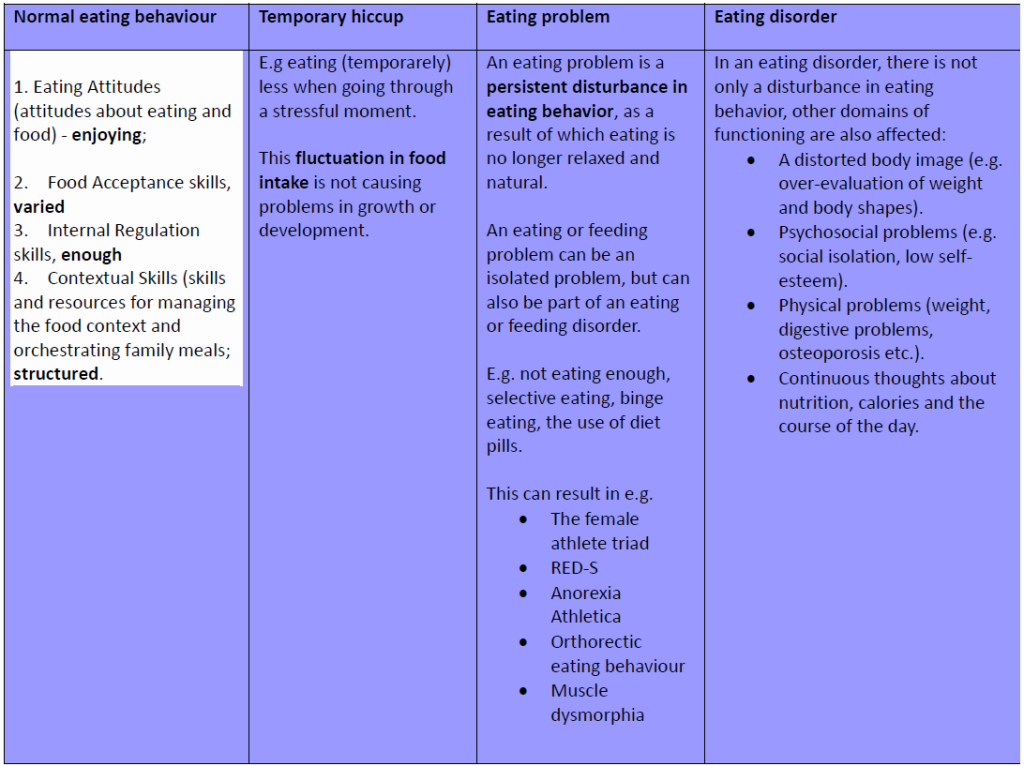The following article on eating disorders is intended solely to provide general concepts and ideas on the topic. It is not a substitute for professional medical advice, diagnosis, or treatment. Always seek the advice of your physician or a qualified nutritionist with any questions you may have regarding a medical condition. This article has been prepared by Master Annick Van Driessche and includes extracts from publications by the organization Eetexpert, which has given its consent for this publication. The content does not reflect the opinions or positions of AETF. AETF has no position on this subject.
Date: 20/06/2024.
Eating problems and eating disorders are situated on a continuum of eating behaviour that ranges from normal eating behaviour to a temporary hiccup to eating problems and finally an eating disorder
Problems usually arise gradually; timely recognition and support prevents more serious problems.
Individual athletes can move back and forth along the spectrum of eating behaviour at any point in time over their career and within different stages of a training cycle (e.g. during the off-season, pre-season, when injured).

Red flags – when to worry about the eating behaviour of the athlete?
Physical signals:
- longer recovery time, longer muscle soreness
- regular (minor) injuries
- sudden change in weight
- muscle cramps, impaired muscle function
- exercising hard, but with little or no results and a decreased training response
- decreased focus, concentration- and coordination problems
- tired, sleeping badly
- decreased immunity, decreased energy level
- frequently having infections of the respiratory tract, abdominal pain, gastrointestinal problems (constipation, bloating, nausea), low heart rate, heart rhythm problems,
- cold hands and feet
- irregular or absence of menstruation
- brittle nails, pale skin
- dehydration or fluid retention
Psychological signals:
- nervous, especially when having weigh-in
- mood swings, being irritable
- perfectionistic, wanting to have control, fear of failure, low self-esteem, lack of self-confidence
- having an unrealistic image of the own body and the target weight
- overly performance-oriented
- fear for changes
- being introvert and/or impulsive and/or a pleaser and/or sensitive
Behavioural signals:
- being overly preoccupied with food and calories
- changes in eating behavior
- eating too little or too much, selective eating
- extra (compulsive) exercise on top of the training schedules*
- continue to exercise despite injuries or illness
- not taking rest days
- check the body excessively (in the mirror)
- avoid the scale or on the contrary weigh excessively
- try to cover up the weight change
- avoid social contact (e.g. eat alone, train alone)
- not using the changing rooms together with others
| Specific signals for the growing athlete: * slow(er) growth, no or late puberty * abnormal lack of energy, lack of motivation * faster loss of focus and coordination * more small aches and pains, crying more quickly or giving up faste |
Healthy eating behaviour in the sports club – much more than nutrition
As a coach or instructor:
- Focus on a healthy life style
A healthy lifestyle helps everyone. Those who live healthier lives directly improve their own health and resilience, even if their weight does not change. A healthy lifestyle is more than just a healthy diet. It is PERKS : https://eetexpert.be/infofiche-spark-a-balanced-lifestyle-alles-english-version/
- Eat VARIED
- Handle EMOTIONS
- MOVE
- Be KIND to yourself
- SLEAP
| Eat varied: think about 4 eating competencies: – Pay attention to a good eating structure with appropriate snacks to support training and with plenty of fluids, and make time for it. – Eat healthy and varied. – Speak to athletes that don’t eat enough. Don’t stimulate diets, but stimulate that food is the fuel for good sports performance. – Contribute to cozy eating moments, eat together with the athletes in a relaxed atmosphere and pay attention for what the athlete is eating. Handle emotions: learning to deal with emotions is part of a healthy lifestyle. Healthy exercise helps to feel power and to regulate emotions and put them into perspective. Move: advocate healthy exercise with a focus on physical and mental fitness instead of burning calories. Focus on fun and tune in to what’s good for the body. Teach athletes to recognize the signs of overtraining. Be kind to yourself: create a positive and safe training climate, look at the progress without comparing with others. Strengthen body satisfaction by making links with what the body can do when properly cared for. Sleap: sleeping has a health-promoting effect. It boosts fitness, immunity and resilience and improves sports performance. So promote sufficient rest between sports moments and speak to athletes who are clearly tired; Monitor injuries closely. |
2. Contribute to good eating skills
- (Teach/learn to) eat structured
- (Teach/learn to) eat inspired
- (Teach/learn to) eat according to what is needed for good further growth
- (Teach/learn to) enjoy eating, with moments in you share with team mates.
3. Work on a positive training climate
Focusing on general well-being promotes a good training climate. Stimulating young people in a growth-oriented way can be done by strengthening them in their 3 basic needs:
- Autonomy or self-choice: involve the athletes as much as possible in choices; Young people feel good when they can do things that align with their own values and goals.
- Belonging or feeling loved: athletes need to build relationships, to feel loved and accepted. Give every athlete attention, regardless of performance; Be respectful of the athletes’ feelings.
- Competency or achievable realistic goals: achievable goals boost self-confidence and commitment; when the athlete feels success, it tastes like more. A goal may be challenging, but take it step by step and focus on fun. Compare the athlete’s performance with previous performances, not with other athletes’ performances. Provide process-oriented feedback, not person-centered feedback.
4. Provide growth-oriented coaching
Show interest in what is going on with your athletes, listen to the concerns about food, weight and appearance. Reinforce what is already going well. Encourage new healthy behaviors. Create a sports environment in which the healthy choice is easy and attractive. Be a good example.
TIPS: what to say about weight?
- Focus on a healthy lifestyle, not on weight. If necessary (e.g. for competition in weight categories), talk about a healthy weight instead of a ‘normal weight’.
- Correct the idea that a body is completely ‘makeable’ and that everyone can have the same measurements.
- Interfere when athletes are having a ‘fat talk’.
- Don’t link performance to someone’s weight.
- Be frugal with weighing moments; always do them privately and only when really necessary. Don’t criticize the athlete’s weight or physique.
TIPS: wat to say about diets?
- Emphasize nutrition is the fuel for good performances.
- Be a role model; emphasize a well-balanced eating structure with snacks in between training sessions, and sufficient drinking moments.
- Stimulate cozy moments, sharing food with the athletes.
- Stimulate athletes to visit a professional sports dietitian if more advise is necessary.
| Watch out for symptoms of the RED-S syndrome (Relative Energy Deficiency in Sport) RED-S is a state of impaired physiological functioning of an athlete’s body due to prolonged low energy availability. At the root of the energy deficit is an imbalance between the total energy intake through food and the energy that is consumed. When insufficient energy is available for a long time, the body limits physiological systems that are not essential for daily survival, with serious consequences for health, mental well-being and sports performance. A combination of low weight, inadequate nutrition, heavy training load, and little attention to recovery can lead to a cascade effect: an imbalance between training, nutrition and recovery causes stress in the body. Stress increases cortisol levels; The functioning of the pituitary gland decreases, leading to a hormonal imbalance. The prefrontal cortex works less, making decision-making more difficult. Anxiety and tension increase, sleep becomes more difficult. Symptoms that may be indicative for RED-S Syndrome: chronic fatigue, recurrent infections and colds, stress fractures or recurrent bone injuries, decreased strength, menstrual problems, gastrointestinal upset, changes in body composition, growth disorders, decreased performance, mood swings. |

